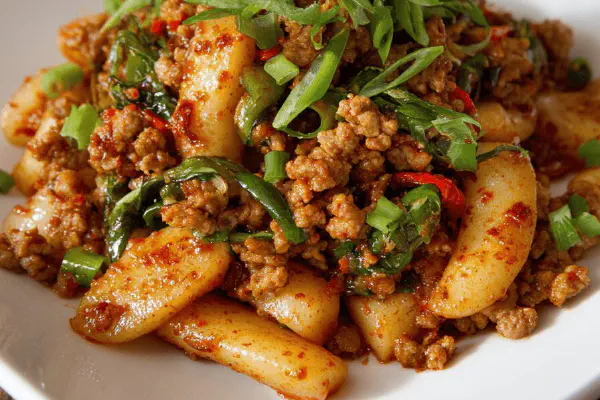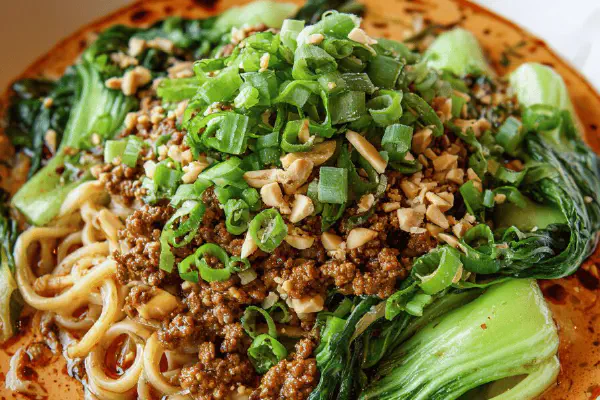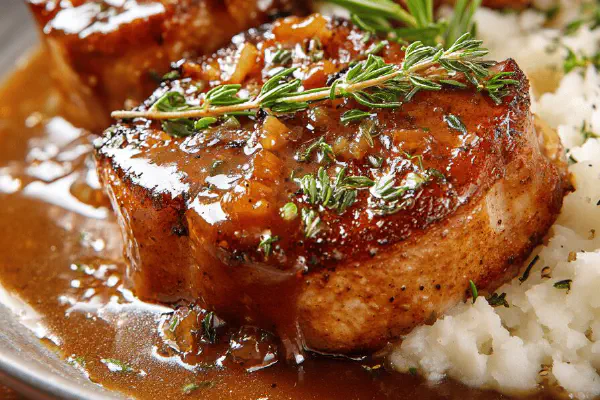Twisted Griot Agrikol

By Emma
Certified Culinary Professional
Ingredients
- 60 ml (1/4 cup) avocado oil
- 50 ml (3 tbsp + 1 tsp) tangy Haitian-style marinade
- 1 kg (2.2 lb) pork shoulder boneless, cut into chunky 4 cm (1.5 inch) cubes
- 900 ml (3.75 cups) beef broth, preferably homemade or low sodium
- 450 ml (1.9 cups) fresh orange juice
- 45 ml (3 tbsp) lime juice
- 3 large garlic cloves, minced fine
- 1 whole Scotch bonnet or habanero pepper
- 1 scallion (white and light green parts), tied with parsley and thyme to make a bouquet garni
- 4 sprigs parsley flat-leaf
- 3 sprigs fresh thyme
- Corn oil for frying
- 1 tbsp tamarind paste (optional, replaces part of lime juice for deeper tang)
About the ingredients
Method
- Heat avocado oil in a heavy deep pot over medium-high heat until shimmering. Toss in the Haitian marinade paste, stir briskly. Watch marinade bubble, darken slightly but don’t burn—medium-high needs watching. Immediately add pork chunks, toss to coat every piece. Cook about 1 1/2 minutes, deglazing any sticky bits at bottom. Searing but not browning hard here. Don’t crowd the pan.
- Add beef broth plus orange juice, lime juice, and tamarind paste if using —pour carefully, watch the sizzle and steam rise. Stir in minced garlic and add whole Scotch bonnet - no poking, keep it whole to avoid overwhelming heat. Prepare bouquet garni by tying scallion, parsley, and thyme into a small bundle with kitchen twine; drop into pot.
- Season generously with salt and freshly cracked black pepper. Stir once for evenness. Bring to a rolling boil. Once boiling, reduce to gentle medium-low simmer, leaving pot uncovered. Expect gentle bubble thuds and subtle steam upward.
- Simmer without lid for roughly 1 hour 40 minutes, stirring every 20 minutes to monitor moisture and prevent sticking. Pork ready when tender but firm—poke with fork, it should slide in with some resistance, definitely not shredding yet. Remove bouquet garni and whole pepper carefully; don’t break pepper skin to control spice release.
- Drain pork pieces with a slotted spoon onto plate lined with thick paper towels; let rest 15 minutes. This resting drains excess liquid and firms the meat, making frying better.
- Meanwhile, heat corn oil in a deep fryer or large heavy skillet to 175–180°C (350–355°F). Watch for shimmering waves and wisps of smoke. Arrange a baking sheet lined with fresh paper towels nearby for draining fried pork.
- Fry pork pieces in small batches, 2 to 4 minutes each, turning occasionally. Look for golden, blistering crisp spots. Listen for steady frying sounds, not frantic splat. Remove to paper towels to drain. They should be crisp outside, juicy inside. If you miss golden edges, the pork will be soggy, ruining the texture.
- Serve with traditional Haitian sides like duriz collé (sticky cornmeal) or plantain pesée. For extra kick, add homemade pikliz or your favorite spicy pickled veg. Can serve also atop coconut rice or mashed cassava for a twist.
Cooking tips
Chef's notes
- 💡 Start with hot avocado oil then add marinade paste fast. Bloom flavors without burning. Quick sear pork chunks one batch at a time. Don’t crowd pan or it steams instead of sears. Stir sticky bits to deglaze but keep pork color pale—avoid browning hard here.
- 💡 Simmer uncovered at medium-low, bubbles soft but consistent. Keeps broth bright and citrus sharp. Stir only gently every 20 minutes; rough stirring shreds meat. Watch pork texture by poking fork—need slight resistance not shredding. Remove bouquet garni and whole pepper carefully to avoid excess heat.
- 💡 Rest pork drained on thick paper towels minimum 15 minutes after simmer. Moisture drains, meat firms up. Crucial before frying or texture turns soggy inside. Use fresh paper towels for best absorption. Rest makes frying crunchier and insides juicy, an underappreciated step.
- 💡 Heat corn oil to 175–180C, watch shimmer and faint smoke cues. Fry pork in small batches 2 to 4 minutes turning gently. Golden blistered spots tell crisp done right. Overcrowd fryer and oil temperature drops, pork absorbs oil, gets greasy and limp. Drain well on paper towels immediately after frying.
- 💡 Bouquet garni tied tight prevents herbs from stray leaves floating in broth. Use scallion white parts plus parsley, thyme. Whole Scotch bonnet pepper inserted but NEVER poke or slice. Puncture releases excessive heat; whole gives slow gentle burn allowing flavor complexity. If heat is unwanted, remove pepper early.
Common questions
Can I substitute Scotch bonnet?
Use habanero or small hot pepper whole. Adjust timing or remove earlier if too spicy. Avoid slicing peppers; whole slow release heat. No pepper gives milder version but loses citrusy fire punch.
What if pork gets mushy?
Overcooking or stirring hard breaks fibers. Aim for tender but firm texture. Slow simmer uncovered helps. Rest after cooking drains moisture, firms meat for frying. Skipping rest means soggy pork.
Can I use vegetable oil instead of avocado?
Avocado oil preferred for high smoke point and buttery aroma. Vegetable oil works but watch burn risk. Corn oil only for frying stage because stays stable at deep-fry temps. Smoke or off-flavors signal oil swap failure.
How to store leftovers?
Cool quickly, airtight in fridge up to 3 days. Reheat gently in pan with minimal added liquid. Fry again briefly to crisp exterior if texture lost. Freezing possible but texture alters; best eaten fresh.



